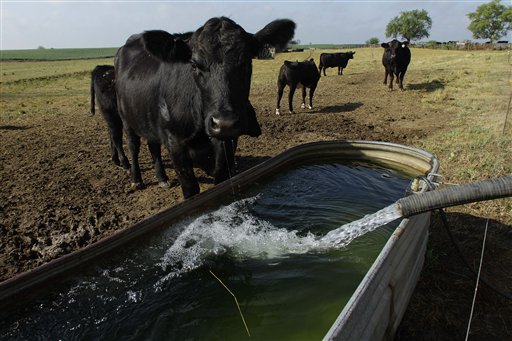
Agricultural News
Peel Finds Cattle Numbers Tight Across North America
Mon, 30 Jun 2014 11:37:24 CDT

Derrell S. Peel, Oklahoma State University Extension Livestock Marketing Specialist, writes in the latest Cow/Calf Corner newsletter
Record high feeder cattle prices leave no doubt that U.S. feeder cattle supplies are extremely tight. On January 1, estimated feeder supplies were down 2.7 percent over the previous year amid indications of heifer retention. There are indications that heifer retention has accelerated in 2014. USDA will release the July Cattle report in about a month which will provide a mid-year estimate of feeder supplies, though no year over year comparisons will be possible since the report was cancelled last year. U.S. feeder supplies will likely be down again with a 2014 U.S. calf crop fractionally smaller than last year and increased heifer retention further squeezing feeder supplies. However, the market attempts to compensate for declining supplies with high prices prompting adjustments wherever possible. U.S. veal slaughter continues to decrease, accelerating a long term trend in recent years. Veal slaughter so far in 2014 is down 15 percent year over year, a pace that would result in annual slaughter that is down 21 percent from the previous ten year average. High U.S. feeder prices also stimulate increased imports of feeder cattle from Canada and Mexico.
Cattle imports from Canada through April were up nearly 12 percent year over year. The imports reflect a changing mix of slaughter and feeder cattle with slaughter cattle down 3 percent and feeder cattle imports up 36 percent. This follows a 28 percent annual increase in Canadian cattle imports in 2013, consisting of 5 percent more slaughter cattle and a 113 percent increase in feeder cattle imports. Changes in the mix of slaughter and feeder cattle imports from Canada partly reflect the impacts of the latest country of origin label (COOL) rules implemented in May, 2013 and partly the strong U.S. demand for feeder cattle. Despite the flexibility to shift between feeder cattle and slaughter cattle, there is a limit to total cattle imports from Canada. The Canadian beef cow herd is the smallest in 20 years and expected herd rebuilding there will limit feeder supplies in coming years.
Reliable cattle inventory data is much harder to find in Mexico but there are strong indications that total cattle numbers have decreased significantly in the past few years including a sharp drop in the cow herd inventory. Drought forced liquidation in 2011 and 2012 resulted in unsustainably large Mexican cattle exports to the U.S. Not surprisingly, U.S imports of Mexican cattle dropped by a third in 2013 compared to 2012. The extremely strong pull of record U.S. feeder prices in 2014 has kept year to date imports close to year ago levels. The monthly import total through April was down about two percent year over year but the preliminary weekly data for May and June suggests that year to date Mexican cattle imports are about five percent higher than last year. Decreased Mexican cattle inventories combined with growing domestic feeder cattle demand in Mexico due to the rapid expansion of feedlot production in the country suggests that current levels of Mexican cattle exports cannot be sustained in the short run and may be permanently reduced in coming years.
In 2011 and 2012, lack of heifer retention due to drought, reduced veal slaughter and increased feeder cattle imports all contributed to temporarily maintaining U.S feeder cattle supplies. Starting in late 2013 and accelerating in 2014, the reality of a still smaller calf crop, increased heifer retention and limited cattle supplies in Canada and Mexico underpin current market prices. Veal slaughter will likely drop a bit more but can only go so low; and the year to date eight percent increase in feeder cattle imports from Canada and Mexico is unlikely to be sustained in the second half of the year. Even the allure of record high cattle prices can only do so much when the cattle simply aren't there. Mexican cattle numbers are extremely tight and I expect U.S. imports of Mexican cattle to moderate in the second half of the year. Canadian feeder supplies will tighten as well though the timing is less certain. Combined cattle inventories in North America are at the lowest level in decades and with herd rebuilding indicated in the U.S., Canada and Mexico, North American feeder cattle supplies will get tighter at least through 2016.
WebReadyTM Powered by WireReady® NSI
Top Agricultural News
More Headlines...



















